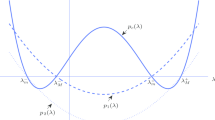Abstract
How do environmental heterogeneity influence propagation dynamics of the age-structured invasive species? We investigate this problem by considering a yearly generation invasive species in time-space periodic habitat. Starting from an age-structured population growth law, we formulate a reaction-diffusion model with time-space periodic dispersal, mortality and recruitment. Thanks to the fundamental solution for linear part of the model, we reduce to study the dynamics of a time-space periodic semiflow which is defined by the solution map. By the recent developed dynamical theory in Fang et al. (J Funct Anal 272:4222-4262, 2017), we obtained the spreading speed and its coincidence with the minimal wave speed of time-space periodic traveling waves, as well as the variational characterization of spreading speed in terms of a principal eigenvalue problem. Such results are also proved back to the reaction-diffusion model.

Similar content being viewed by others
References
Berestycki H, Hamel F (2002) Front propagation in periodic excitable media. Comm Pure Appl Math 55:949–1032
Berestycki H, Hamel F (2012) Generalized transition waves and their properties. Comm Pure Appl Math 65:592–648
Cabré X, Roquejoffre J-M (2013) The influence of fractional diffusion in Fisher-KPP equations. Commun Math Phys 320:679–722
Cantrell RS, Cosner C (2003) Spatial ecology via reaction-diffusion systems. Wiley, New York
Hamel F, Roques L (2010) Fast propagation for KPP equations with slowly decaying initial conditions. J. Differ. Equ. 249:1726–1745
Fang J, Yu X, Zhao X-Q (2017) Traveling waves and spreading speeds for time-space periodic monotone systems. J. Funct. Anal. 272:4222–4262
Fang J, Lai X, Wang F-B (2020) Spatial dynamics of a dengue transmission model in time-space periodic environment. J Differ Equ 269:149–175
Garnier J (2011) Accelerating solutions in integro-differential equations. SIAM J Math Anal 43:1955–1974
Garroni MG, Menaldi JL (1992) Green functions for second order parabolic integro-differential problems. Chapman and Hall/CRC Research Notes in Mathematics Series, UK
Kot M (1992) Discrete-time traveling waves: ecological examples. J Math Biol 30:413–436
Kot M, Lewis MA, Driessche P (1996) Dispersal data and the spread of invading organisms. Ecology 77:2027–2042
Kot M, Schaffer WM (1986) Discrete-time growth-dispersal models. Math Biosci 80:109–136
Lax PD (2002) Functional Analysis. Wiley-Interscience, New York
Hsu S-B, Zhao X-Q (2008) Spreading speed and traveling waves for non-monotone intergro-difference equations. SIAM J Math Anal 40:776–789
Liang X, Zhao X-Q (2007) Asymptotic speeds of spread and traveling waves for monotone semiflows with applications. Comm Pure Appl Math 60:1–40
Liang X, Yi Y, Zhao X-Q (2006) Spreading speeds and traveling waves for periodic evolution systems. J Differ Equ 231:57–77
Lou Y, Zhao X-Q (2017) A theoretical approach to understanding population dynamics with seasonal developmental durations. J Nonlinear Sci 27:573–603
Lutscher F (2019) Integrodifference equations in spatial ecology. Springer, New York
Liu K, Lou Y, Wu J (2017) Analysis of an ante structured model for tick populations subject to seasonal effects. J Differ Equ 263:2078–2112
Metz JA, Diekmann O (1986) The dynamics of physiologically structured populations. Lecture notes in biomathematics. Springer-Verlag, Germany
Nadin G (2009) Traveling fronts in space-time periodic media. J Math Pures Appl 92:232–262
Nadin G (2009) The principal eigenvalue of a space-time periodic parabolic operator. Ann Mat Pura Appl 188:269–295
Nolen J, Rudd M, Xin J (2005) Existence of KPP fronts in spatially-temporally periodic advection and variational principle for propagation speeds. Dyn Partial Differ Equ 2:1–24
Pan Y, Fang J, Wei J (2018) Seasonal influence on age-structured invasive species with yearly generation. SIAM J Appl Math 78:1842–1862
Pan Y, Su Y, Wei J (2019) Accelerating propagation in a recursive system arising from seasonal population models with nonlocal dispersal. J Differ Equ 267:150–179
Rawal N, Shen W, Zhang A (2015) Spreading speeds and traveling waves of nonlocal monostable equations in time and space periodic habitats. Discrete Contin Dyn Syst 35:1609–1640
Roques L, Hamel F, Fayard J et al (2010) Recolonisation by diffusion can generate increasing rates of spread. Theor Popul Biol 77:205–212
So J, Wu J, Zou X (2001) A reaction-diffusion model for a single species with age structure. I. Travelling wavefronts on unbounded domains. Proc Roy Soc A 457:1841–1853
Weinberger HF (1982) Long-time behavior of a class of biological models. SIAM J Math Anal 13:353–396
Weinberger HF (2002) On spreading speeds and traveling waves for growth and migration models in a periodic habitat. J Math Biol 45:511–548
Weinberger HF, Kawasaki K, Shigesada N (2008) Spreading speeds of spatially periodic integro-difference models for populations with nonmonotone recruitment functions. J Math Biol 57:387–411
Xin J (1991) Existence and stability of travelling waves in periodic media governed by a bistable nonlinearity. J Dynam Differ Equ 3:541–573
Zinner B, Harris G, Hudson W (1993) Traveling wavefronts for the discrete Fisher’s equation. J Differ Equ 105:46–62
Zhao X-Q (2003) Dynamical systems in population biology. CMS Books Math Springer, New York
Acknowledgements
This work received fundings from the NSF of China (12001533, 11771108). We are very grateful to the anonymous referee for careful reading and valuable comments, which led to an improvement of the original manuscript.
Author information
Authors and Affiliations
Corresponding author
Additional information
Publisher's Note
Springer Nature remains neutral with regard to jurisdictional claims in published maps and institutional affiliations.
Rights and permissions
About this article
Cite this article
Pan, Y. Propagation dynamics for an age-structured population model in time-space periodic habitat. J. Math. Biol. 84, 19 (2022). https://doi.org/10.1007/s00285-022-01721-7
Received:
Revised:
Accepted:
Published:
DOI: https://doi.org/10.1007/s00285-022-01721-7




